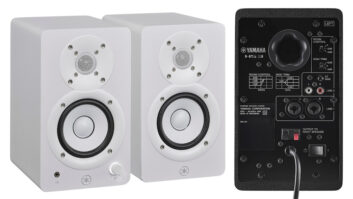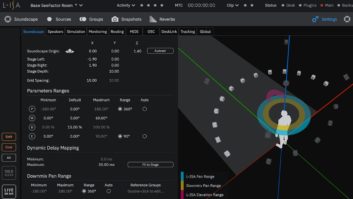
Seven years ago, I reviewed Yamaha’s HS Series monitors (the HS50M monitor and HS10W subwoofer in Mix’s April 2006 issue) and was mightily impressed. The overriding hallmark was an eminently crystal-clear sound when placed on console-top shelves—positioning that defenestrates most other monitors’ clarity of reproduction. Nevertheless, Yamaha saw room for improvement. The HS Series has been updated, with better performance promised for the three full-range monitors and subwoofer comprising the product line. For this review, I took a stereo pair of the largest two-way model, the HS8, for a spin.
What’s New
The HS8 features a newly designed 1-inch dome tweeter and 8-inch woofer. (The woofer’s white cone harks back to its seminal forebear, the NS10M.) A 75-watt amp drives the woofer, which is protected by a built-in limiter, while a 45W amp juices the tweeter. A white LED illuminates—behind the Yamaha logo—on the cabinet’s face when power is applied.
A number of design elements were used to reduce resonance, noise and diffractive effects in the HS8’s cabinet, which measures 9.8×15.4×13.1 inches (WxHxD). The corners of the MDF (medium-density fiberboard) enclosure are anchored using a three-way mitered-joint technique borrowed from architectural design protocol. The cabinet’s rear-firing port is designed to quell any potential air vortex, reducing noise up to 6 dB. To reduce diffraction that would otherwise degrade imaging, the tweeter is mounted in a shallow waveguide and the sides of the cabinet are rounded along their top and bottom edges. The waveguide’s considerable thickness minimizes distortion-birthing vibration.
Surveying the HS8’s rear panel, a Room Control switch compensates for bass build-up when you must place the monitor near a wall; the three-way switch provides 0, -2 or -4 dB attenuation below 500 Hz. A three-way High Trim switch boosts or attenuates response 2 dB above 2 kHz—the drivers’ crossover frequency—and alternatively provides a null (0dB) setting. The XLR connector and TRS phone jack input connections are both balanced, but the latter can accept unbalanced signals. The XLR connector does not latch—a minor concern. A continuously variable level control attenuates output to mute silence when turned all the way down; it’s detented at the noon position for +4dB nominal input level and accommodates -10dB input when cranked to the max. A heat sink (for the amplifiers), rocker-style power switch and IEC power receptacle round out the rear panel. The included detachable AC cord measures roughly eight feet in length, longer than that provided for most monitors and allowing greater flexibility in placement. The HS8 weighs 22.5 pounds and consumes 60 watts of power.
The HS8’s frequency response is stated to be 47 Hz to 24 kHz, -3 dB, with 10dB down points at 38 Hz and 30 kHz. Examining the monitor’s frequency-response chart, the most noticeable deviation in response is a dip between 6 and 9 dB, with a nadir of roughly -3.5 dB. Otherwise, the spec departs no more than about 1dB from ruler-flat response from 50 Hz to well over 20 kHz.
In the Control Room
Yamaha recommends placing the HS8 at least five feet from the nearest wall for truest response when bypassing its filters, but that wasn’t possible in my small control room. I placed a pair of HS8s in vertical orientation on Primacoustic Recoil Stabilizers—situated on workstation shelves—about three feet from the nearest wall. (Recoil Stabilizers decouple monitors from shelves, dramatically improving imaging and impulse response.) In my control room, an Acoustic Sciences Corporation Attack Wall (a set of modular tube traps) is positioned to prevent sound emanating from the rear of the monitors from reflecting off the front wall. The Attack Wall quells speaker-boundary effects, pinpointing imaging and tightening the low end at my mix position.
Listening back to my mastered mixes with the HS8s’ filters nulled, imaging was very good and the spectral balance very even, save for mildly understated sibilance and a slight buildup in the upper-bass and low-midrange bands. I could clearly hear fundamental tones produced by a four-string electric bass down to about an F# on the low string, below which notes were audible but understated.
After activating a 2dB cut below 500 Hz using the Room Control filter on each monitor, the imaging and transient response became positively outstanding, and the upper-bass and low-midrange bands sounded crystal-clear. Most surprising was the total absence of flabbiness in the bass band I’ve come to expect from monitors that employ a bass reflex port. The only drawback was that the bass response sounded less extended. I wish the HS8 offered a bell-curve filter that mildly attenuated the upper-bass and low-midrange bands; even with using Recoil Stabilizers, there is often a residual sympathetic resonance in this area when monitors are placed on shelves, and a filter that targets only that area would have preserved the HS8’s bass extension. That said, including a third filter would surely have raised the HS8’s price. If you think your own placement might necessitate using the HS8’s Room Control filter, simply add a subwoofer having a built-in tunable high-cut filter to your setup to bring the bass band back into perfect balance. (Yamaha’s new HS8S subwoofer can vary its high-cut corner frequency from 80 to 120 Hz.) In fact, even using a flat Room Control setting, you’ll need a subwoofer to be able to accurately assess what’s happening in the bottom octave (from 20 to 40 Hz) of your mix; this is true for virtually all near-field monitors.
Placing the HS8s in horizontal orientation—still on shelves, and with tweeters to the outside—the imaging was very good but couldn’t compare to the faultless imaging displayed in vertical orientation. With both setups, I never felt a need to goose the HS8’s High Trim control; the high-frequency detail this monitor provides is superb. In fact, the HS8 still produced outstanding imaging, transient response and high-frequency detail with the High Trim control adjusted to attenuate response 2 dB above 2 kHz (with the Room Control filter also in the -2dB position); the sound just had a little less air and depth. The HS8 can produce very loud SPLs if you need it to.
Score Card
The hallmark of the HS Series monitors has always been that they provide extraordinary clarity with shelf-top placement, and the new HS8 is no exception. Especially with this setup, the HS8 outperforms other monitors I’ve heard in its price range. Add superb transient response, imaging and depth and tight bass reproduction to its list of attributes, and the verdict can only be two thumbs up. Way up.
Michael Cooper is a recording, mix, mastering and post-production engineer and the owner of Michael Cooper Recording in Sisters, Oregon.
Try This
While mixing a music production, use this simple test to confirm the lead vocals are loud enough to be clearly heard: Very slowly turn down your control-room monitor level until no sound is heard. If the lead vocal is the last element of the mix to go silent, you can be certain it won’t sound too low on any reasonably good system.
Product Summary
COMPANY: Yamaha
PRODUCT: HS8
WEBSITE:yamahaproaudio.com
PRICE: $499 each
PROS: Superb clarity, detail, imaging and transient response. Tight bass reproduction. Built-in filters and level control. Long, detachable AC cord. Excellent value.
CONS: Very slightly understated reproduction of sibilance. XLR connector doesn’t latch.







